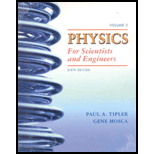
Concept explainers
(a)
The time required for
(a)
Answer to Problem 41P
Explanation of Solution
Given:
Magnitude of charge on an ion,
Magnitude of magnetic field,
Magnitude of velocity of ion
Mass of the ion
Angle between the velocity of ion and magnetic field,
Radius of the orbit of ion
Time taken to complete the semicircle by ion
Distance traveled to complete the semicircle
Formula Used:
Time taken is given as
Magnetic force on the ion moving in magnetic field is given
Centripetal force is given as
Calculation:
Magnetic force on the ion moving in magnetic field is given
For the ion to move in a circular orbit, the necessary centripetal force is provided by the magnetic force acting on it. Hence
Distance traveled to complete the semicircle is same as the circumference of semicircle
Time taken to complete the semicircle is given as
So time taken by ion
Conclusion:
The time taken by ion
(b)
The time required for
(b)
Answer to Problem 41P
Explanation of Solution
Given:
Magnitude of charge on an ion,
Magnitude of magnetic field,
Magnitude of velocity of ion
Mass of the ion
Angle between the velocity of ion and magnetic field
Radius of the orbit of ion
Time taken to complete the semicircle by ion
Distance traveled to complete the semicircle
Formula Used:
Time taken is given as
Magnetic force on the ion moving in magnetic field is given
Centripetal force is given as
Calculation:
Magnetic force on the ion moving in magnetic field is given
For the ion to move in a circular orbit, the necessary centripetal force is provided by the magnetic force acting on it. Hence
Distance traveled to complete the semicircle is same as the circumference of semicircle
Time taken to complete the semicircle is given as
So time taken by ion
Conclusion:
The time taken by ion
Want to see more full solutions like this?
Chapter 26 Solutions
Physics for Scientists and Engineers, Vol. 3
- Show that for V less than zero, InetI0.arrow_forwardReview. The use of superconductors has been proposed for power transmission lines. A single coaxial cable (Fig. P23.73) could carry a power of 1.00 103 MW (the output of a large power plant) at 200 kV, DC, over a distance of 1.00 103 km without loss. An inner wire of radius a = 2.00 cm, made from the superconductor Nb3Sn, carries the current I in one direction. A surrounding superconducting cylinder of radius b = 5.00 cm would carry the return current I. In such a system, what is the magnetic field (a) at the surface of the inner conductor and (b) at the inner surface of the outer conductor? (c) How much energy would be stored in the magnetic field in the space between the conductors in a 1.00 103 km superconducting line? (d) What is the pressure exerted on the outer conductor due to the current in the inner conductor? Figure. P23.73arrow_forward(a) At what speed will a proton move in a circular path of the same radius as the electron in Exercise 22.12? (b) What would the radius of the path be it the proton had the same speed as the electron? (c) What would the radius be if the proton had the same kinetic energy as the electron? (d) The same momentum?arrow_forward
- A double charged ion is accelerated to an energy of 32.0 keV by the electric field between two parallel conducting plates separated by 2.00 cm. What is the electric field strength between the plates?arrow_forwardAn e- is accelerating through a potential difference V of 23 kV. How much KE it will gain [in J and eV]arrow_forwardCould you please explain how to do this? I'm not sure how to use the slope (-18 Vm) to solve the problem. Thanks!arrow_forward
- An air-filled parallel-plate capacitor with a 2.79mm gap width has a capacitance value of 1.77μF and holds a charge of 8.38μC. 1) What is the magnitude, in volts per meter, of the electric field near the center of the gap?arrow_forward40. According to the continuity of current, if we consider closed surface, then current out of the surface must be equal to the rate at which the number of charges inside the surface is decreasing. a. True b. False.arrow_forwardAn evacuated tube uses an accelerating voltage of 39 kV to accelerate electrons to hit a copper plate and produce X-rays. Non-relativistically, what would be the maximum speed (in m/s) of these electrons? m/sarrow_forward
- A cylindrical wire of cross-section 0.2 m and 1 m length has a uniform total charge of 5 mC across the volume. The voltage applied across the length is 2 V. What is the electric field at the center of the wire?arrow_forwardTwo atoms of the same substance, one singly ionized and the other triply ionized, are eachaccelerated from rest through same potential difference. The ions enter the same uniformmagnetic field at 90 degrees. Derive an expression fora) their velocity (V2/ V1) entering the field. b) their radii (r2/ r1) of curvature in the field.arrow_forwardTwo atoms of the same substance, one singly ionized and the other triply ionized, are eachaccelerated from rest through same potential difference. The ions enter the same uniformmagnetic field at 90o. Derive an expression fora) their velocity (V2/ V1) entering the field.b) their radii (r2/ r1) of curvature in the field.arrow_forward

 Physics for Scientists and Engineers: Foundations...PhysicsISBN:9781133939146Author:Katz, Debora M.Publisher:Cengage Learning
Physics for Scientists and Engineers: Foundations...PhysicsISBN:9781133939146Author:Katz, Debora M.Publisher:Cengage Learning Principles of Physics: A Calculus-Based TextPhysicsISBN:9781133104261Author:Raymond A. Serway, John W. JewettPublisher:Cengage Learning
Principles of Physics: A Calculus-Based TextPhysicsISBN:9781133104261Author:Raymond A. Serway, John W. JewettPublisher:Cengage Learning College PhysicsPhysicsISBN:9781938168000Author:Paul Peter Urone, Roger HinrichsPublisher:OpenStax College
College PhysicsPhysicsISBN:9781938168000Author:Paul Peter Urone, Roger HinrichsPublisher:OpenStax College Glencoe Physics: Principles and Problems, Student...PhysicsISBN:9780078807213Author:Paul W. ZitzewitzPublisher:Glencoe/McGraw-Hill
Glencoe Physics: Principles and Problems, Student...PhysicsISBN:9780078807213Author:Paul W. ZitzewitzPublisher:Glencoe/McGraw-Hill University Physics Volume 3PhysicsISBN:9781938168185Author:William Moebs, Jeff SannyPublisher:OpenStax
University Physics Volume 3PhysicsISBN:9781938168185Author:William Moebs, Jeff SannyPublisher:OpenStax





